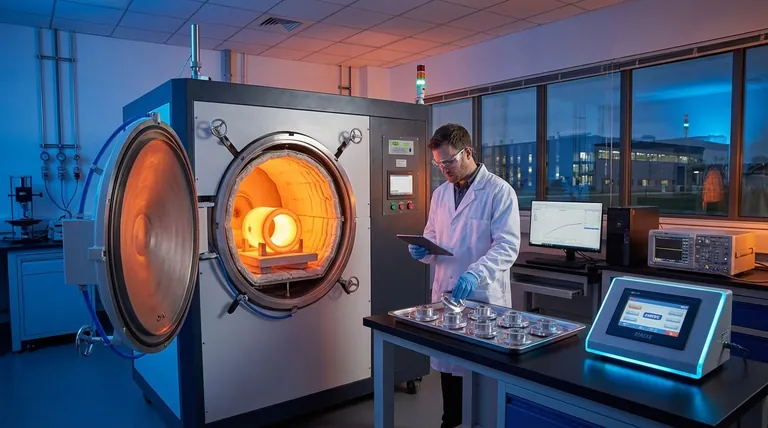While vacuum heat treatment offers an exceptionally clean and controlled environment, its primary disadvantages are significant equipment and operational costs, inherent limitations on cooling rates, longer processing cycles, and unsuitability for certain metal alloys. These factors make it a specialized process that is not universally applicable or economically viable for every application.
The core trade-off with vacuum heat treatment is not about the quality of the result, which is almost always superior. Instead, the decision hinges on whether the high cost, slower throughput, and specific technical limitations are justified by the need for a pristine, unoxidized, and precisely controlled metallurgical outcome.

Why the "Perfect" Environment Comes at a Price
The primary drawbacks of vacuum heat treatment are economic and operational. Creating a near-perfect environment requires substantial investment and specialized knowledge that isn't always necessary.
Significant Capital Investment
A vacuum furnace is a complex piece of machinery. The initial purchase price is substantially higher than that of a conventional atmosphere furnace due to the need for a sealed chamber, robust vacuum pumps, sophisticated control systems, and precise sensors.
Increased Operational Complexity
Operating and maintaining a vacuum system requires a higher level of technical skill. Staff must be trained in vacuum technology, leak detection, and pump maintenance, adding to long-term operational costs and potential downtime if not managed correctly.
Longer Processing Cycles
Achieving a deep vacuum takes time. The pump-down phase before heating begins can significantly extend the total cycle time compared to an atmosphere furnace, which can be a bottleneck in a production environment.
Understanding the Trade-offs: Key Technical Limitations
Beyond the cost, vacuum heat treatment has inherent physical and chemical limitations that make it unsuitable for certain materials and desired outcomes.
Restricted Cooling Rates
Heat transfer in a vacuum is dominated by radiation, which is less efficient than the convection used in atmosphere furnaces. While gas quenching with inert gas under pressure is used to cool parts, it is almost always slower than aggressive liquid quenching (e.g., water, brine, or certain oils).
This slower cooling can be a critical disadvantage for low-hardenability steels or very thick parts that require an extremely rapid quench to achieve the desired hardness and microstructure.
Material and Alloy Constraints
The vacuum environment can be detrimental to certain materials. At high temperatures and low pressures, some alloying elements with a high vapor pressure—such as zinc, cadmium, manganese, and lead—can literally boil off the surface of the part.
This phenomenon, known as outgassing or sublimation, can alter the surface chemistry and mechanical properties of the alloy, making vacuum treatment unsuitable for many brasses, bronzes, and some tool steels.
Limited Throughput for Mass Production
Vacuum furnaces are inherently batch-processing systems. Parts are loaded, the chamber is sealed, the cycle runs, and then the parts are unloaded. This is less efficient for very high-volume, continuous manufacturing compared to conveyor-style atmosphere furnaces where parts are constantly moving through.
Making the Right Choice for Your Goal
Evaluating these disadvantages against the process's clear benefits is crucial for making a sound engineering and business decision.
- If your primary focus is minimizing cost for non-critical parts: A conventional atmosphere furnace is almost always the more economical choice.
- If your primary focus is achieving maximum hardness in low-hardenability alloys: The faster cooling rates of an aggressive liquid quench in a conventional process may be necessary.
- If your primary focus is high-volume, continuous production: A continuous belt atmosphere furnace is likely a better operational fit for your workflow.
- If you are working with alloys containing high-vapor-pressure elements: You must confirm that vacuum processing will not damage the material's surface composition.
Understanding these limitations is the key to leveraging the unique power of vacuum heat treatment effectively, ensuring you choose the right tool for the right job.
Summary Table:
| Disadvantage | Key Impact |
|---|---|
| High Capital & Operational Cost | Significant investment in equipment and specialized staff training. |
| Slower Cooling Rates | Limited by radiation-based heat transfer; may not suit low-hardenability steels. |
| Longer Processing Cycles | Pump-down and heating phases extend total cycle time, reducing throughput. |
| Material Constraints | Unsuitable for alloys with high-vapor-pressure elements (e.g., zinc, lead) due to outgassing. |
| Batch-Processing Nature | Less efficient for high-volume production compared to continuous atmosphere furnaces. |
Need help choosing the right heat treatment solution for your lab? At KINTEK, we specialize in lab equipment and consumables, offering expert guidance to help you balance cost, efficiency, and material requirements. Whether you're processing high-precision components or high-volume batches, our solutions ensure optimal performance. Contact our experts today to discuss your specific needs and discover how KINTEK can enhance your laboratory's capabilities!
Visual Guide

Related Products
- Vacuum Heat Treat Furnace with Ceramic Fiber Liner
- Vacuum Heat Treat Sintering Brazing Furnace
- Molybdenum Vacuum Heat Treat Furnace
- Vacuum Heat Treat Furnace and Levitation Induction Melting Furnace
- 2200 ℃ Tungsten Vacuum Heat Treat and Sintering Furnace
People Also Ask
- What is a vacuum furnace used for? Unlock Purity in High-Temperature Processing
- How to vacuum out a furnace? A Step-by-Step Guide to Safe DIY Maintenance
- What materials are used in a vacuum furnace? A Guide to Hot Zone Materials and Processed Metals
- Can I vacuum the inside of my furnace? A Guide to Safe DIY Cleaning vs. Professional Service
- What are the advantages of a vacuum furnace? Achieve Superior Purity and Control in Heat Treatment



















